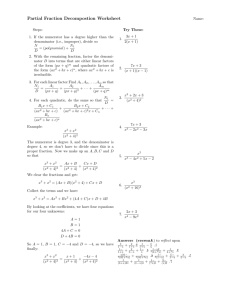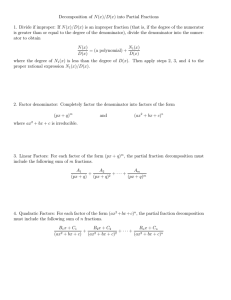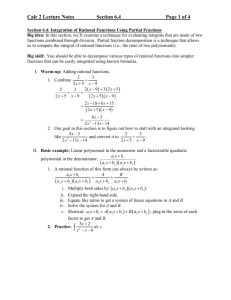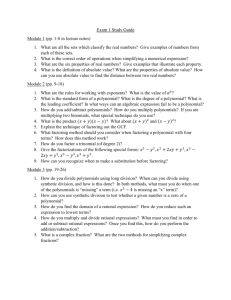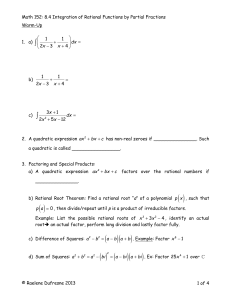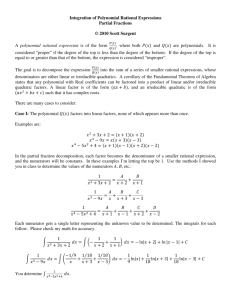7.4 Integration of Rational Functions by Partial Frac
advertisement
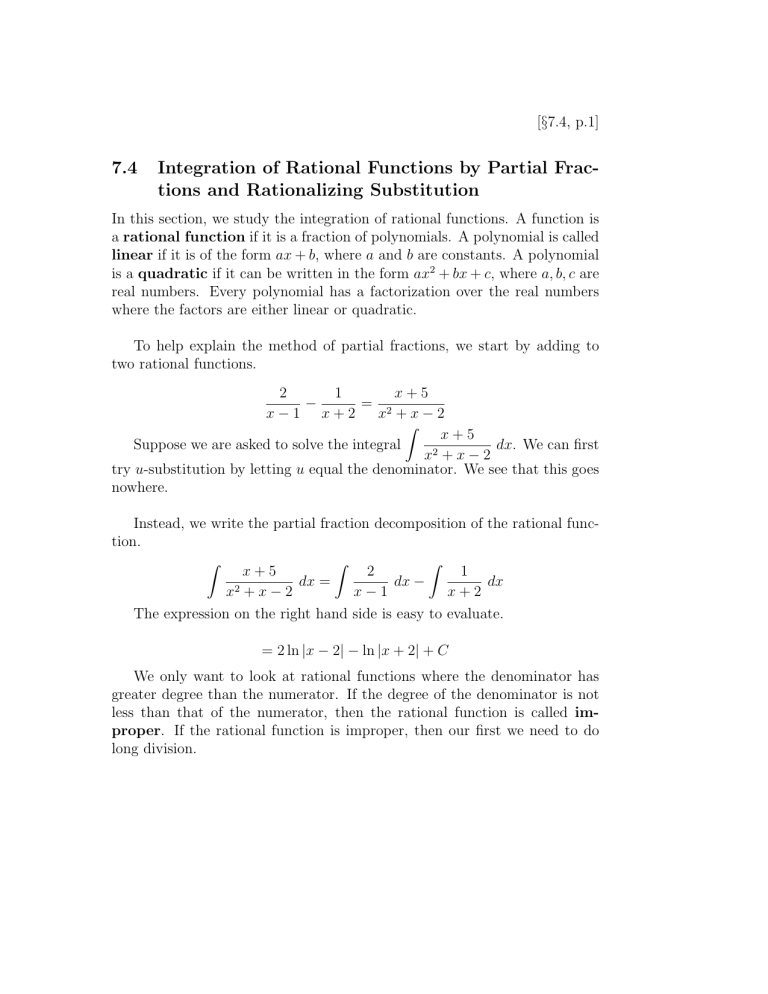
[§7.4, p.1] 7.4 Integration of Rational Functions by Partial Fractions and Rationalizing Substitution In this section, we study the integration of rational functions. A function is a rational function if it is a fraction of polynomials. A polynomial is called linear if it is of the form ax + b, where a and b are constants. A polynomial is a quadratic if it can be written in the form ax2 + bx + c, where a, b, c are real numbers. Every polynomial has a factorization over the real numbers where the factors are either linear or quadratic. To help explain the method of partial fractions, we start by adding to two rational functions. 1 x+5 2 − = 2 x−1 x+2 x +x−2 Z x+5 Suppose we are asked to solve the integral dx. We can first 2 x +x−2 try u-substitution by letting u equal the denominator. We see that this goes nowhere. Instead, we write the partial fraction decomposition of the rational function. Z Z Z 2 1 x+5 dx = dx − dx x2 + x − 2 x−1 x+2 The expression on the right hand side is easy to evaluate. = 2 ln |x − 2| − ln |x + 2| + C We only want to look at rational functions where the denominator has greater degree than the numerator. If the degree of the denominator is not less than that of the numerator, then the rational function is called improper. If the rational function is improper, then our first we need to do long division. [§7.4, p.2] Z Example. Find x3 + x dx. x−1 [§7.4, p.3] Now assume that we have a rational function that is not improper. Assume that we have an integral of the form Z P (x) dx Q(x) where deg P < deg Q. A polynomial with real coefficients can be written as the product of linear factors ax + b and irreducible quadratic factors ax2 + bx + c, b2 − 4ac < 0. The rational function can then be expressed as a sum of partial fractions. Here are the steps we should follow: 1. If the rational function is improper, do long division to write the function as a sum of a polynomial and a proper rational function. 2. For the proper rational function, factor the denominator. 3. Write the proper fraction as a sum of partial fractions. To perform the last step, we have four separate cases. Case I: The denominator Q(x) is a product of distinct linear factors. Q(x) = (ax1 + b1 )(a2 x + b2 ) · · · (ak x + bk ) Then we can write an expansion R(x) A1 A2 Ak = + + ··· + Q(x) a1 x + b 1 a2 x + b 2 ak x + b k [§7.4, p.4] Z Example. Evaluate x2 + 2x − 1 dx. 2x3 + 3x2 − 2x [§7.4, p.5] Z Example. Find x2 dx dx, a 6= 0. − a2 [§7.4, p.6] Case II: Q(x) is a product of liner factors, some of which are repeated. If a linear factor is repeated r times, then instead of using A1 /(a1 x + b1 ), we use A1 A2 Ar + + ··· + 2 a1 x + b1 (a1 x + b1 ) (a1 x + b1 )r Example. : Find x4 − 2x2 + 4x + 1 dx. x3 − x 2 − x + 1 [§7.4, p.7] Case III: Q(x) contains irreducible quadratic factors, none of which is repeated. The term involving the quadratic factor can be written as Ax + B ax2 + bx + c For example, (x − 2)(x2 x A Bx + C Dx + E = + 2 + 2 2 + 1)(x + 4) x−2 x +1 x +4 To integrate the last two terms, use the following formula. Z Example. Evaluate dx 1 −1 x = tan +C x 2 + a2 a a 2x2 − x + 4 dx. x3 + 4x [§7.4, p.8] A quadratic is called irreducible if it cannot be factored into two linear factors over the real numbers. The discriminant of a quadratic ax2 + bx + c is the expression b2 − 4ac. When we write out the quadratic formula, we see that this is the expression under the radical. If the discriminant is negative, then the quadratic does not have real roots, and is therefore irreducible. If the rational function has a denominator that is an irreducible quadratic of the form ax2 + bx + c, then we can complete the square. Z Example. Evaluate x2 4x − 5 dx. + 4x + 13 [§7.4, p.9] Case IV: Q(x) contains repeated irreducible quadratic factors. If Q(x) has the factor (ax2 +bx+c)r , b2 −4ac < 0, then use the expansion A1 x + B1 A2 x + B2 Ar x + Br + + ··· 2 2 2 ax + bx + c (ax + bx + c) (ax2 + bx + c)r Example. Write the partial fraction expansion of the following. x3 + x2 + 1 x(x − 1)(x2 + x + 1)(x2 + 1)3 [§7.4, p.10] Z Example. Evaluate 1 − x + 2x2 − x3 dx. x(x2 + 1)2 [§7.4, p.11] Rationalizing Substitutions We are now going to look at integrating functions that contain radical expressions, or nonrational expressions. If a functions contains nonrational expressions, then we use u-substitution. We let u equal the radical. Z √ Example. Evaluate x+4 dx. x
